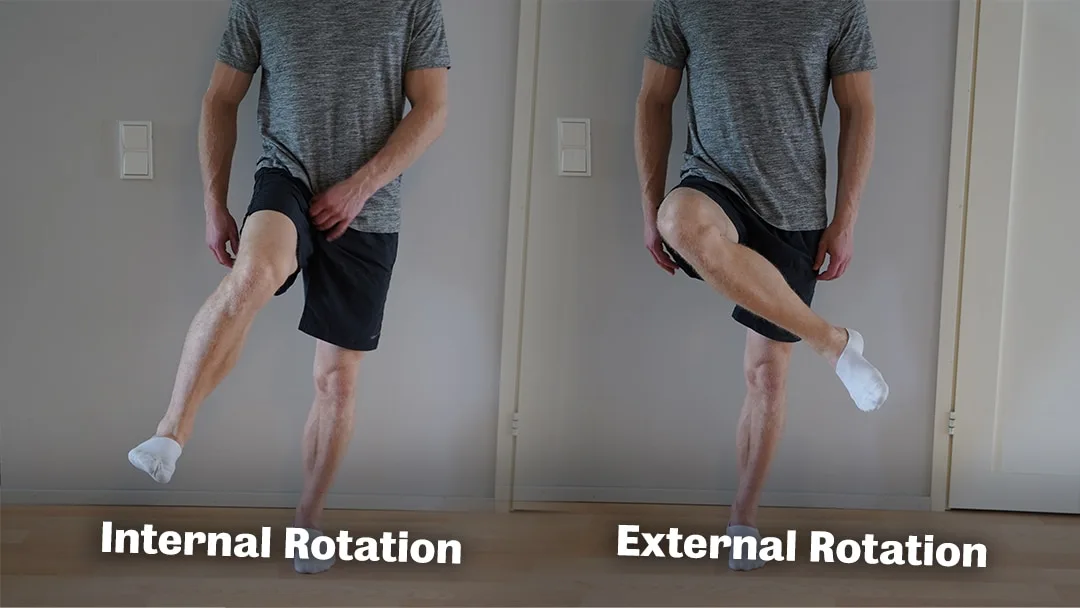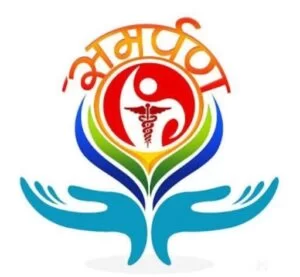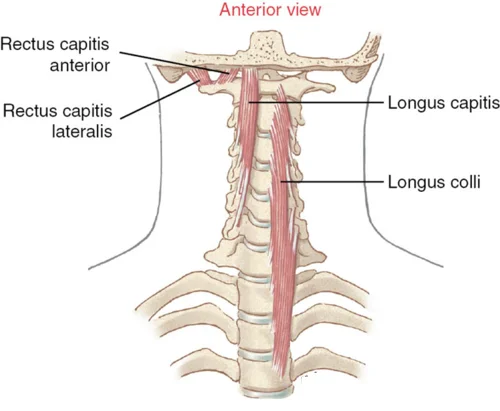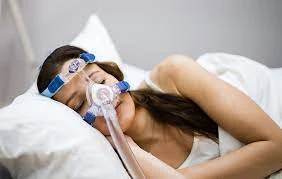Hip Internal Rotation and External Rotation
Table of Contents
What is a Hip Internal Rotation and External Rotation?
Hip internal rotation and external rotation are two important movements of the hip joint that allow for a wide range of motion and contribute to overall lower limb function. These rotational movements occur along the longitudinal axis of the femur bone and play a crucial role in activities such as walking, running, and sports involving lower body movements.
Internal rotation of the hip refers to the movement of the thigh bone inward, towards the midline of the body. This movement involves the rotation of the femur bone within the hip socket. It is an essential component of various functional tasks, such as crossing the legs, squatting, and twisting movements during athletic activities. Adequate hip internal rotation is also necessary for optimal lower limb alignment and joint mechanics during gait.
External rotation, on the other hand, refers to the movement of the thigh bone outward, away from the midline of the body. This motion involves the rotation of the femur bone away from the hip socket. Hip external rotation is crucial for movements such as stepping out to the side, pivoting, and generating power in rotational sports like golf or tennis. It also contributes to the stability of the hip joint and helps maintain proper alignment of the lower limb during weight-bearing activities.
Impairments in hip internal and external rotation can lead to functional limitations and musculoskeletal problems. Restricted hip internal rotation may result in compensatory movements and increased stress on other joints, such as the knee or lower back. Limited hip external rotation can impact activities that require a wide range of motion, leading to decreased performance and increased risk of injury.
Assessment and management of hip internal and external rotation are crucial in the fields of physical therapy, sports rehabilitation, and orthopedics. Various techniques and exercises can be utilized to improve the hip rotational range of motion, such as stretching, joint mobilizations, and strengthening exercises targeting the hip musculature.
Understanding the significance of hip internal and external rotation is vital for professionals working with individuals who require rehabilitation or performance enhancement. By addressing any limitations in these movements and optimizing hip joint function, individuals can improve their overall movement quality, prevent injuries, and enhance their performance in various physical activities.
Hip Internal Rotation
What Is Hip Internal Rotation?
- Hip internal rotation refers to the movement of the hip joint in which the femur (femur) rotates inward or medially toward the midline of the body. It is one of the primary movements of the hip along with hip flexion, extension, abduction, and adduction.
To better understand the internal rotation of the hips, imagine that you are standing with your feet pointed forward. When the femur rotates inward, motion occurs in the hip joint, and the knee and leg also rotate inward. The opposite movement, where the femur rotates outward or laterally away from the midline, is called external rotation of the hip.
Internal rotation of the hip is associated with various activities and movements such as walking, running, squatting, and cross-legged sitting. It is also an important component in many sports and exercises, including golf, baseball, and martial arts.
Proper hip internal rotation is necessary to maintain good hip mobility, stability, and overall lower body function. Limited internal rotation of the hip can lead to compensatory movements or imbalances that can increase the risk of injury or negatively impact performance.
It’s worth noting that hip internal rotation can vary from person to person due to factors such as anatomy, flexibility, and muscle imbalances. If you are concerned about your hip mobility or suspect a problem, it is recommended that you speak with a doctor or qualified physiotherapist who can provide a thorough assessment and appropriate guidance.
Hip Internal Rotatores Muscles
The internal rotators of the hip are a group of muscles in the hip area that work together to rotate the femur (femur) inward, toward the midline of the body. These muscles play an important role in various movements such as walking, running, and maintaining balance.
Here are some of the main internal rotator muscles of the hip:
- Gluteus Medius: This muscle is located on the lateral side of the hip and acts as an abductor and internal rotator of the hip. It is responsible for stabilizing the pelvis during walking and other weight-bearing activities.
- Gluteus minimus: This muscle lies below the gluteus Medius and helps in the abduction and internal rotation of the hip. It also aids in hip joint stabilization.
- Tensor fasciae lathe: This muscle is located on the lateral side of the hip and helps in flexion, abduction, and internal rotation of the hip. It operates with the minims and medius of the gluteus.
- Piriformis: Deep into the buttock is where the piriformis muscle is found. It comes from the sacrum and connects to the femur’s head. It is the main muscle involved in hip rotation, including internal rotation.
- Obturator internus and externus: these muscles are located on the inner surface of the pelvis and help to rotate the femur internally. The obturator internal is deeper and originates from the inside of the pelvis, while the obturator externus is more superficial and originates from the outside of the pelvis.
- Gemellus superior and inferior: These muscles are small and are located deep in the hip area. They work together with the obturator muscles to help the internal rotation of the hip.
- Quadratus femoris: This muscle is located on the back of the hip joint and is involved in adduction and internal rotation of the hip joint.
It is important to note that the hip joint is a complex structure where several muscles work together to produce a variety of movements, including internal rotation. Additionally, the strength and activation of these muscles can vary from person to person. If you have specific concerns or need advice about these muscles, it is recommended that you speak to a doctor or a qualified physiotherapist.
Range Of Motion Of Hip Internal Rotation
Internal hip rotation range of motion can vary from individual to individual and is affected by factors such as anatomical structure, flexibility, and any underlying conditions. However, I can provide an overview of the range of motion of the internal rotation of the hip.
The normal range of motion for hip internal rotation is usually between 30 and 45 degrees. This means that, on average, a person should be able to rotate their femur (femur) inward toward the midline of their body approximately 30-45 degrees from the neutral or starting position. It is important to note that this range can vary from person to person. It is worth mentioning that tension or restrictions in the muscles, tendons, ligaments, or attached structures surrounding the hip can limit the range of motion of the internal rotation of the hip. In some cases, certain diseases or injuries, such as hip arthritis, labral tears, or muscle imbalances, can also affect a range of motion.
If you are concerned about hip internal rotation or are experiencing limitations or discomfort, a consultation with a physician or qualified physical therapist is advised. They can assess your specific situation, provide a more detailed assessment of your range of motion, and recommend appropriate measures or exercises to address any limitations or problems.
To take a look at the variety of movements of hip internal rotation, you could carry out the subsequent procedure:
- Preparation: Find a comfortable, flat floor for the man or woman being assessed to lie down on, along with a remedy desk or exercise mat. Ensure there may be sufficient area for the hip to transport freely.
- Positioning: Have the man or woman lie on their return with their legs prolonged straight.
- Landmark identification: Locate the bony prominences or landmarks on the man or woman’s body. For the hip, perceive the more trochanter, that’s the bony bump at the aspect of the higher thigh close to the hip joint.
- Starting role: With the man or woman in a mendacity role, flex their knee to a 90-diploma attitude, bringing their foot flat on the floor. This role stabilizes the pelvis and minimizes compensatory movements.
- Measurement: Place one hand at the man or woman’s knee to stabilize it, even as the alternative hand is used to keep the ankle. Gently rotate the hip inward, aiming to convey the man or woman’s knee toward the floor. Simultaneously, look at the variety of movement and be aware of any restrictions, discomfort, or pain.
- Recording: Use a goniometer, a specialized device for measuring joint angles, to quantify the hip inner rotation. Align the desk-bound arm of the goniometer with the man or woman’s trunk, align the movable arm with the thigh bone (femur), and be aware of the altitude at which the thigh bone is circled inward.
- Repeat: Perform the size in some instances to make sure accuracy and be aware of any adjustments or discrepancies among repetitions.
It’s crucial to be aware that the variety of movement evaluations ought to be executed with the aid of using a certified healthcare professional, along with a bodily therapist or doctor, who has reveled in accomplishing those evaluations. They may have the knowledge to interpret the results, perceive any abnormalities or limitations, and offer suitable suggestions or remedies if necessary.
Hip Internal Rotation Test
The Thomas test is a commonly used assessment method to measure hip internal rotation. This can be done as follows.
- Lie on a firm surface, such as a treatment table or exercise mat.
- Bring one leg up to the chest while bending it.
- Hold the knee close to the chest with both hands for stabilization.
- Let the other leg hang over the edge of the surface, keeping it straight.
- Relax your back and neck against the surface.
- Slowly lower the bent leg to the surface so that the straight leg falls down.
- Pay attention to any sensations or limitations you feel in the hip of the straight leg.
- Monitor your movement and any discomfort or limitations you experience.
- Repeat the test on the other side.
If you notice limited internal rotation on one or both sides during the Thomas test, this may indicate tightness or strain in the internal rotator muscles of the hip. However, it is important to note that this test is a general indication and should not replace a thorough evaluation by a physician or qualified physical therapist.
If you are concerned about hip internal rotation or suspect limitations or discomfort, it is recommended that you consult a doctor who can evaluate your specific situation, provide a more detailed assessment, and recommend appropriate procedures or exercises according to your needs.
Exercise For Hip Internal Rotation
Here’s an exercise you can try to improve internal hip rotation:
- Seated Hip Internal Rotation Stretch:
- Sit on a bench or chair’s edge.
- Cross one ankle over the opposite knee and create a square shape with your legs.
- Gently squeeze the crossed knee to encourage a deeper stretch.
- Maintain a straight back and proper posture.
- Hold the stretch for 20-30 seconds while you feel a slight stretch in the pelvic area.
- Repeat on the other side.
- Supine Internal Rotation Stretch:
- Lie to your returned on a mat or the ground together along with your legs extended.
- Bend your proper knee and area your proper foot flat at the ground.
- Cross your left ankle over your proper knee, developing a figure-4 shape.
- Use your fingers to softly pull your proper knee closer to your chest till you sense a stretch on your left hip.
- Hold the stretch for 20-30 seconds at the same time as retaining your higher frame relaxed.
- Repeat on the opposite side, crossing your proper ankle over your left knee.
3. Prone Internal Rotation Exercise:
- Lie face down on a mat or the ground together along with your legs extended.
- Bend your proper knee at a 90-diploma attitude and raise your foot closer to the ceiling.
- Keeping your hips and pelvis grounded, slowly rotate your proper leg inward, aiming to convey your heel closer to your contrary hip.
- Hold for some seconds on top of the variety of motion, feeling the contraction on your hip muscles.
- Return to the beginning function and repeat for 10-15 repetitions.
- Switch to the opposite leg and carry out the equal exercise.
4. Standing Internal Rotation with Resistance Band:
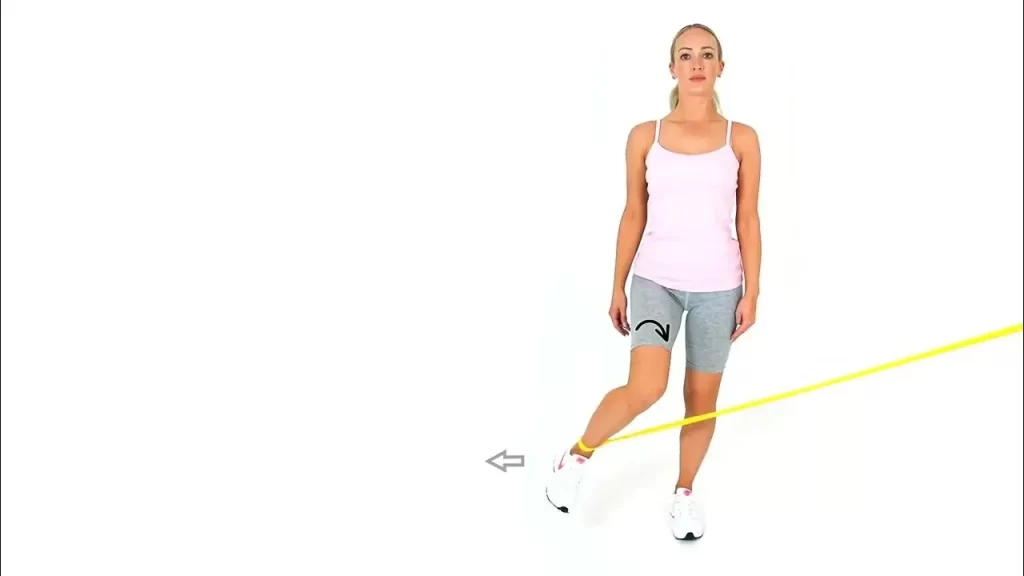
- Attach a resistance band around a strong anchor factor, which includes a door cope with or post, at hip height.
- Stand sideways to the anchor factor and loop the band across the ankle of your long-way leg.
- Position yourself a long way far from the anchor factor to create anxiety within the band.
- Keep your toes hip-width aside and interact with your middle for stability.
- Rotate your long-way leg inward in opposition to the band’s resistance, bringing your foot closer to your midline.
- Hold for a 2nd on the top of the movement, then return to the beginning function.
- Complete 10-15 repetitions on one leg earlier than switching to the opposite side.
This seated stretch targets the internal rotators of the hips and can help improve their flexibility over time. Remember to perform the exercise without pain and avoid forcing the stretch.
It is important to note that individual needs and abilities may vary and it is always recommended to consult a doctor or qualified physiotherapist before starting an exercise program, especially if you have a pre-existing condition or injury that may affect your pelvic mobility. They can give you an accurate assessment, recommend exercises tailored to your needs and make sure you perform the exercises correctly and safely.
Special Test For Hip Internal Rotation
One specific test often used to assess hip internal rotation is the Craig test. This can be done as follows.
- Lie face down on a treatment table or exercise mat, legs straight.
- The examiner palpates the greater trochanter of the femur, which is a ball of bone on the outside of the hip.
- Slowly bend the knee of the tested leg to a 90-degree angle.
- Turn the pelvis inward until the greater trochanter is most visible to the examiner.
- The examiner measures the angle between the leg and the table or carpet with a goniometer.
- The measured angle represents the internal rotation of the hip.
The normal range of internal rotation of the hip as measured by the Craig test is about 30 degrees. If the measured angle is greater or less than this range, it may indicate hypermobility or a limited range of motion, respectively. It is important to note that the Craig test is only one of several specialized tests available to assess hip internal rotation. This should be done by a qualified doctor who can interpret the results in the context of your own condition and provide appropriate guidance.
Remember that self-diagnosis or relying only on special tests is not recommended. If you are concerned about the internal rotation of your hip, or if you suspect limitations or discomfort, it is best to consult a doctor who can provide a thorough evaluation, including specific tests, and recommend the most appropriate activity for you. individual needs.
Hip External Rotation
What Is Hip External Rotation?
- Hip external rotation refers to the movement of the hip joint in which the femur (femur) rotates outward or laterally away from the midline of the body. This movement is primarily performed by the external rotator muscles of the hip, which include the piriformis, gemellus superior, gemellus inferior, obturator internus, obturator externus, and quadratus femoris.
Hip external rotation is an important movement in various activities, including sports, functional movements, and daily life. It plays an important role in activities such as throwing a ball, hitting, crossing the legs, and performing certain yoga poses.
Strengthening the external rotators of the hip and maintaining flexibility can be beneficial for athletes, those involved in rotational movements, and those seeking overall stability and function of the hip. Exercises that target hip external rotation include crunches, side leg crunches, seated or standing hip external rotation with resistance bands, and various yoga poses such as pigeon pose.
It is important to note that proper form and technique must be emphasized when performing hip external rotation exercises to prevent injury and ensure optimal muscle activation. If you have any particular concerns or medical conditions related to your hip or any other joint, it is always recommended that you consult a qualified health or exercise professional before starting a new exercise program.
Hip External Rotatores Muscles
The hip external rotators are a group of muscles responsible for the external rotation of the hip. These muscles work together to rotate the femur (thigh) outward, or to the side, away from the midline of the body. The main external rotator muscles of the hip are:
- Piriformis: This muscle is located deep in the gluteal region and is one of the main external rotators of the hip. It runs from the sacrum (base of the spine) to the outer part of the femur (greater trochanter).
- Gemellus Superior: lies below the piriformis muscle and runs from the gemellus superior ischial spine (part of the pelvis) to the greater trochanter. This helps the external rotation of the hip.
- Gemellus Inferior: The gemellus inferior lies below the gemellus superior muscle and connects the ischial spine to the greater trochanter. It works with other external rotators to rotate the pelvis.
- Obturator Internus: This muscle originates on the inner surface of the pelvic bone (obturator membrane and surrounding bones) and moves outward to attach to the greater trochanter. It plays an important role in the external rotation of the hip.
- Obturator Externus: The obturator externus, located below the internal sphincter, also originates from the pelvis and passes into the greater trochanter. This helps the external rotation of the hip.
- Quadratus Femoris: This muscle lies deep in the gluteal muscle and runs from the ischial tube (sit bone) to the greater trochanter. It promotes external rotation of the hip along with the other external rotators.
These muscles work synergistically to provide stability, control, and movement during hip external rotation. Strengthening and maintaining the flexibility of these muscles can help improve athletic performance, functional movement, and overall hip function.
Range Of Motion Of Hip External Rotation
Hip external rotation range of motion can vary between individuals and is influenced by factors such as genetics, joint structure, and flexibility. The normal range of motion for hip external rotation is about 40-60 degrees on average.
One commonly used method for measuring hip external rotation is the “hip neutral” position, where the thigh is in line with the body and the knee is bent at 90 degrees. In this position, the amount of rotation achieved when the leg is moved outside the midline of the body is measured.
It is important to note that the range of motion can be different for each hip joint and can also vary based on factors such as muscle tension, previous injuries, or medical conditions. In addition, hip external rotation asymmetry is not uncommon because one hip has a greater range of motion than the other.
Maintaining adequate hip external rotation is important in activities that require rotational movements, such as sports, dance, and daily work. Stretching and range of motion exercises can help improve and maintain hip external rotation flexibility. If you have particular concerns about your hip range of motion or are experiencing limitations or discomfort, it is recommended that you consult a doctor or rehabilitation specialist for an accurate assessment and proper guidance.
To test the variety of movement of hip outside rotation, you may comply with the steps:
- Preparation: Find a comfortable, flat floor for the character being assessed to lie down on, inclusive of a remedy desk or exercise mat. Ensure there may be sufficient area for the hip to transport freely.
- Positioning: Have the character lie on their return with their legs prolonged straight.
- Landmark identification: Locate the bony prominences or landmarks at the character’s body. For the hip, discover the extra trochanter, that’s the bony bump at the facet of the top thigh close to the hip joint.
- Starting function: With the character in a mendacity function, flex their knee to a 90-diploma perspective, bringing their foot flat on the floor. This function stabilizes the pelvis and minimizes compensatory movements.
- Measurement: Place one hand at the character’s knee to stabilize it, whilst the opposite hand is used to keep the ankle. Gently rotate the hip outward, aiming to transport the character’s foot far from the midline of the body. Simultaneously, look at the variety of movement and be aware of any restrictions, discomfort, or pain.
- Recording: Use a goniometer, a specialized device for measuring joint angles, to quantify the hip outside rotation. Align the desk-bound arm of the goniometer with the character’s trunk, align the movable arm with the thigh bone (femur), and be aware of the perspective at which the thigh bone is turned around outward.
- Repeat: Perform the dimension in some instances to make certain accuracy and be aware of any modifications or discrepancies among repetitions.
Remember, it is vital to have a certified healthcare professional, inclusive of a bodily therapist or doctor, carry out a variety of movement assessments. They have the knowledge to interpret the results, discover any abnormalities or limitations, and offer suitable hints or remedies if needed.
Hip External Rotation Test
The hip external rotation test is a physical examination technique that assesses the range of motion and flexibility of the hip external rotator muscles. This can help identify restrictions or tightness in those muscles that can affect pelvic function and performance. Here is a description of the hip external rotation test procedure:
- Starting position: Begin lying on your back on a flat surface, such as an exercise mat or exam table. Keep your legs extended and relaxed.
- Leg positioning: Bend one knee and bring it to your chest, keeping your feet flat. It stabilizes the pelvis and prevents compensatory movements.
- Hip External Rotation: Slowly rotate the bent leg outward or to the side, trying to bring the knee as close to the surface as possible. It is important to keep one leg and hip still during the movement.
- Measurement: The examiner can use a goniometer, a special tool with a protractor-like device, to measure the external rotation angle of the hip. Place the center of the axis of the goniometer over the hip joint, and align one hand with the midline of the body and the other parallel to the lower part of the arm.
- Range Of Motion Of Assessment: The examiner notes the degree of hip external rotation achieved by reading the goniometer scale at the point where the lower arm is aligned.
- Repeat: The test is usually performed on both hips to compare range of motion and detect asymmetry.
It is important to remember that a hip external rotation test is best performed by a trained physician or rehabber who can accurately assess the range of motion and interpret the results. They can also provide appropriate guidance and recommendations based on the test results.
Exercise For Hip External Rotation
There are several exercises that can help strengthen and improve the hip’s external rotation. here are some samples:
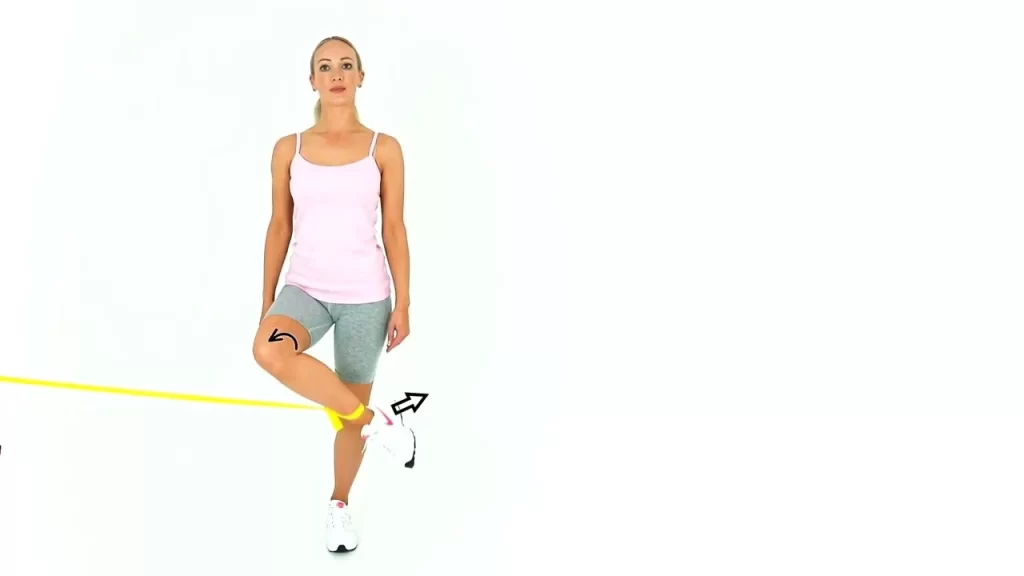
- Clamshells: Kneel down on your side with your feet close together. Keep your feet in contact with each other and open your knees as much as possible without straining. Hold for a moment, then slowly bring your knees together. Repeat several times on each side.
- Seated Hip External Rotation: Sit on a chair or bench with your knees bent at a 90-degree angle and your feet on the floor. Over your knees, wrap a resistance band over your thighs. Keep your feet in contact with the floor and push your knees out against the resistance of the strap and open your thighs. Hold for a moment, then release and repeat several times.
- Side-Lying Leg Lifts: Your legs should be stretched and piled atop one another while you lay on your side. Keeping the upper leg straight, lift it as high as possible while maintaining control. Hold for a moment, then lower the leg back down. Repeat several times on each side.
- Standing External Rotation with a Resistance Band: Stand with your feet shoulder-width apart and the resistance band tied around your lower legs above your ankles. Keeping your knees slightly bent, step to the side with one leg, extending the resistance band. Then join the legs again. Repeat the side step motion alternately several times.
- Pigeon Pose: This yoga pose stretches the external hip rotators. Start on all fours, then bring the other knee up and place it behind the wrist. Slide the other leg straight behind you. Sit tall and, if comfortable, slowly lean forward, placing your hands on the floor in front of you. Hold the position for about 30 seconds to one minute on each side.
Remember to start with a comfortable range of motion and gradually increase the intensity or resistance as the hip external rotators get stronger. It’s crucial to keep appropriate form and pay attention to your body. If you have any conditions or concerns, consult your doctor or fitness professional before starting a new exercise program.
Special Test For Hip External Rotation
Special tests may be done to assess hip external rotation and identify any problems or limitations. Here are some examples:
- Craig’s test: This test is usually used to measure the angle of maximum external rotation of the hip. This can be done as follows.
- Begin lying face down on the examination table.
- Bend your knee to a 90-degree angle.
- The examiner palpates the greater trochanter (bone on the side of the hip).
- With your leg relaxed, the examiner will rotate your hip outward until the trochanter is felt to lift.
- Once the maximum external rotation position is found, the examiner measures the angle between the table and the leg with a goniometer.
- The angle represents the amount of external rotation of the hip.
The Craig test can help determine if there is limited or excessive external rotation of the hip joint.
- Ober’s test: This test evaluates the flexibility and tightness of the tensor fasciae lata (TFL) and iliotibial (IT) bands, which can affect hip external rotation. This can be done as follows.
- Lie flat on your side with your legs slightly bent at the knees.
- The inspector stands behind you and bends the top of your pelvis 90 degrees.
- The examiner then stretches the upper back, keeping it in line with your body.
- With the leg extended, the examiner releases the leg, causing it to descend to the table or floor.
- The inspector observes whether the leg remains horizontal or falls below the horizontal line.
- When the leg drops, it indicates tension in the TFL or IT band, which can limit the external rotation of the hip. Trained healthcare or rehabilitation professionals should perform these special tests to ensure an accurate interpretation of results. They can provide valuable information about hip function, muscle flexibility, and potential problems. If you have specific problems or concerns about hip external rotation, it is recommended that you speak with a doctor who can assess your condition and provide appropriate guidance.
Summary
Understanding the significance of hip internal and external rotation is vital for professionals working with individuals who require rehabilitation or performance enhancement. By addressing any limitations in these movements and optimizing hip joint function, individuals can improve their overall movement quality, prevent injuries, and enhance their performance in various physical activities.
FAQs
Hip internal rotation is the turning of your femur (thigh bone) inward closer to your pelvis – so rotating inwards. As you do so, your foot actions are far from your body. We try this motion lots of instances a day; each whilst exercising, and at some point in everyday activities.
The inner rotation of the shoulder is the rotation closer to the center of the body, whereas the outside rotation is the motion withinside the contrary direction, that’s far from the center of the body.
The gluteal muscular tissues include the gluteus maximus, gluteus medius, gluteus minimus, and tensor fasciae latae. The gluteus maximus, that’s a big muscle withinside the buttocks, is the maximum effective outside rotator muscle of the hip.
Having a practical variety of hip inner rotation (IR) is so critical for lots of things. You want it to carry out your fine with hinging actions like deadlifts or even non-hinging actions like squatting as it allows you to get into function and use the right mechanics.
The External rotation workout objective is the infraspinatus muscle that’s a completely critical muscle of the rotator cuff. The rotator cuff muscular tissues assist to offer a balance for the shoulder joint. The major characteristic of the infraspinatus muscle is to rotate the humerus, or lengthy arm bone, far from the body.
Internal Rotation is an often-unnoticed workout for the shoulders. It is critical, however, because it allows fortify the rotator cuff, will increase the steadiness of the shoulder joint, and improves the variety of motion. When finished often and in appropriate form, the primary advantage is damage reduction.

